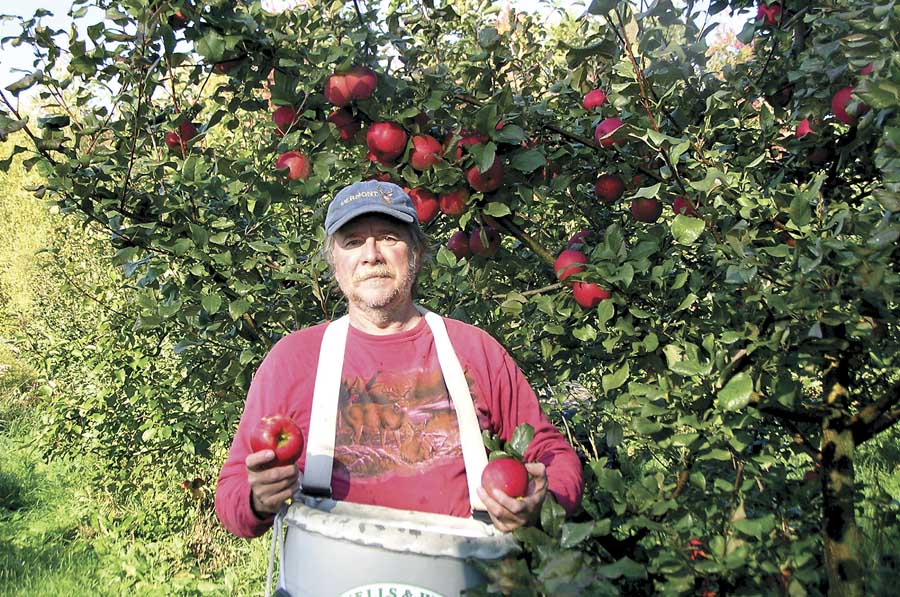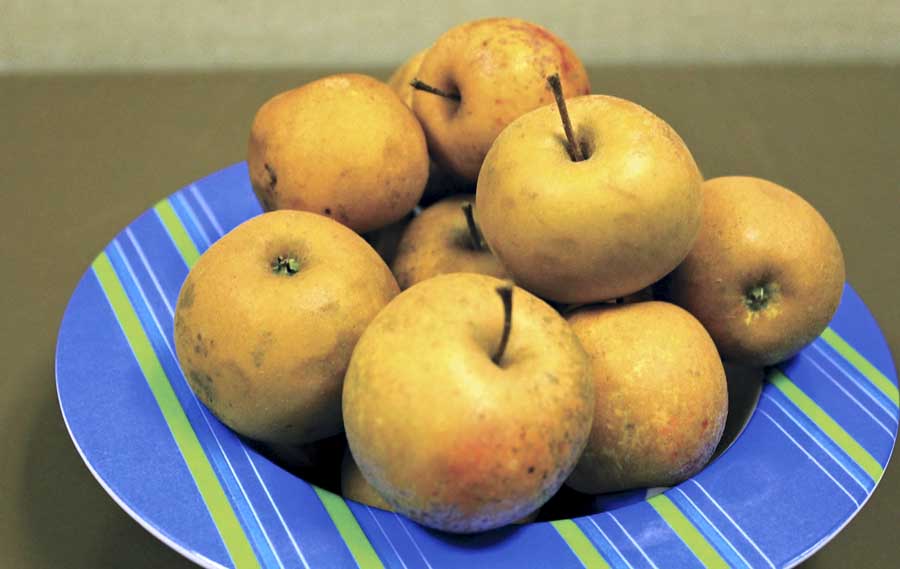
Bill Mayo, shown here harvesting one of his 300 Honeycrisp trees, discovered the Franklin Cider Apple at the edge of his orchard in northern Vermont.(Courtesy Bill Mayo)
Sometimes good things come in large packages.
For the owner of a small orchard in New England, that “good thing” came in the form of a big and beautiful chance-seedling tree that so happens to produce just the kind of apples that are in high demand by the rapidly expanding hard cider market.
The fruit is called the Franklin Cider Apple after the orchard’s location in Franklin, Vermont.
The discovery of the one-of-a-kind bittersharp apple tree actually heralds back to 2008, but at that time orchard owner Bill Mayo only saw its potential for the sweet cider that he and his wife Sue sell in their country store.
“I used to walk by this tree, which is right on the edge of my small gentleman’s orchard, as I like to call it, and I’d pick apples off of it. They were always very high in sugar and had an astringency that would leave this wonderful dryness in my mouth, so I thought it would be a really nice ingredient to put into the sweet cider in our store,” he said.
He devised a sweet-cider blend that included about 5 percent juice from the Franklin Cider Apple, and his customers took to it right away. “I make all I can, and I cannot keep it in the store. People say it’s the best they’ve ever had anywhere,” he said.
As Mayo continued to make and sell the sweet-cider blend, his appreciation for the tree’s other attributes also grew. For one thing, it was a survivor. Estimated to be at least 60 years old, the only care it had ever received was a bit of pruning, but it still stood strong in the Zone 3 temperatures on his farm.
“This tree doesn’t show any dead wood or other signs that it’s unhealthy,” he said. “It’s just an incredibly vibrant tree, and that says a lot about its winter hardiness.”
It also shows some disease resistance, Mayo said. “I’ve always marveled at the fact that there was no foliar scab and no scab on the fruit, which is very russeted and thick-skinned. That’s pretty amazing for a tree that didn’t have any chemicals used on it. That scab resistance caught my interest as a grower.”
In addition, the tree is a heavy producer of apples and juice. Last fall, Mayo harvested 30 bushels off the parent tree and squeezed 2.74 gallons per bushel, “which is incredible throughput for a cider apple,” he said.
To top it off, harvesting was a simple affair, with those 30 bushels harvested in just a couple of hours.
“We laid these big tarps under the tree and literally just shook the tree. It was just unbelievable how the apples rained down on the tarps,” he said, noting that this feature makes the tree perfect for mechanical harvesting.
Hard cider
In 2013, a friend of Mayo’s decided to dabble in hard ciders, and since Mayo owns a store, he thought maybe he could put in a growler system and do some of his own hard cider branding.
He ended up fermenting about 150 gallons blended with the chance-seedling apple. “What it did to hard cider was wonderful. I realized we had something I considered very special,” he said.
Mayo then sent out samples for analysis to Terence Bradshaw, tree fruit and viticulture specialist with the University of Vermont, and to cideries.
The analyses showed that the Franklin Cider Apple exceled in the three major cider-apple qualities: sugars, tannins and acidity.

Growing to about 1.75 inches in diameter, the Franklin Cider Apple is a thick-skinned apple with the hallmarks of a potentially excellent hard-cider apple: high sugars, acidity and tannins. (Courtesy Bill Mayo)
Sugars came in at between 16.9 and 19 Brix. “That’s really sweet for any apple,” Mayo said. Tannins in the Franklin Cider Apple measured up well against traditional cider apples at 0.36 percent, and also exhibited high acidity.
Armed with those results, he approached Steve Stata at Hall Home Place, which is known for its ice cider and hard cider.
Stata didn’t jump on the bandwagon until he and Mayo attended a cider-makers meeting, and he heard a speaker expound about bittersharps’ importance to making a good brew.
“Everybody started bemoaning the fact that there were almost no good bittersweets or bittersharps around, and Bill says to me, ‘This is what I’ve been telling you!’” he said. Stata tried Mayo’s hard-cider samples and was impressed enough to join Bradshaw at Mayo’s orchard for the fall harvest of that lone Franklin Cider Apple tree.
“Terry took a couple of bushels and I took the rest, and it made a very nice cider. In fact, I put up about 1,000 liters of it this past fall,” Stata said.
Stata named his hard cider the Blen Franklin, debuting the blend at the Farmhouse Tap and Grille restaurant in nearby Burlington, Vermont. “Everybody liked the astringency, and they liked the fact that we were able to keep the apple flavor as well. We actually also had our other variety there, and it seemed like people liked the Blen Franklin a little bit better,” he said.
His only lament is that commercial production of the Franklin Cider Apple tree is at least four years away.
Likewise, Steve Cummins of Cummins Nursery in Ithaca, New York, is looking forward to more trees after tasting the “excellent” juice from its apples.
“So far, all the info is from one tree on one farm,” Cummins said. “It’s generally not a good idea to make too much of a new variety until test plots with many different growers and cider makers report back.” Nonetheless, he said, “I think it has the potential to be a great variety because the claim is that it is an annual bearer and is very cold hardy. Time will tell.”
More trees are coming, according to Elmer Kidd, chief production officer of Stark Bro’s Nursery and Orchards Co. of Louisiana, Missouri. After working with Mayo to patent the tree, the nursery began developing scion trees in the greenhouse from “about a cigar box full of wood of various sizes” that Mayo delivered, Kidd said.
“From that wood, I’ve developed a production block and we will have about 1,500 for sale this year.” It’s progressing well so far, he added. “Most of the scion trees were developed in the greenhouse, and they seem to have very vigorous roots, and the tree stem seems vigorous.”
The nursery has already received many inquiries about the Franklin Cider Apple, Kidd said, and plans to produce quite a few trees in the next few years.
In the meantime, Mayo continues to be impressed with the tree and its apples. “When you pull all the feedback together, everything looks excellent,” he said. “I think it has tremendous merit for the hard cider industry. It really is a beautiful tree.” •
– by Leslie Mertz, Ph.D., a freelance writer based in Gaylord, Michigan.






Leave A Comment